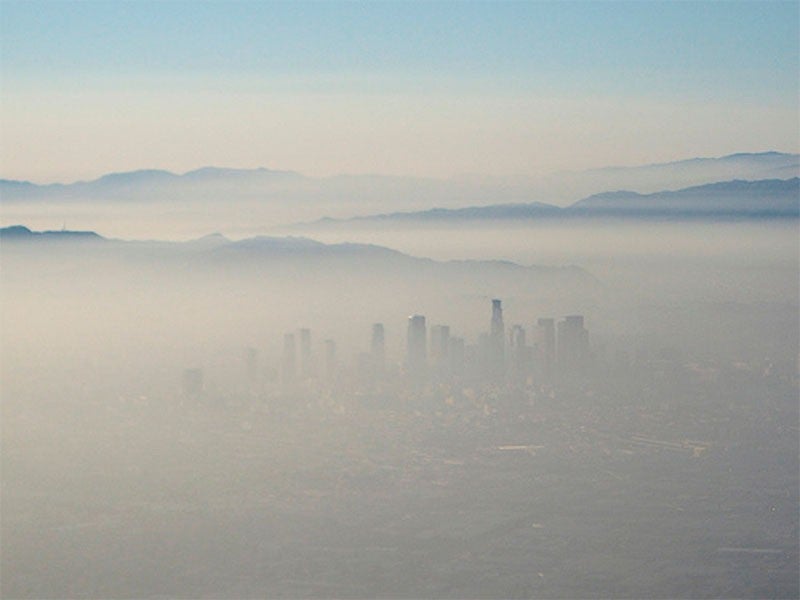We’re Suing Pruitt for Ignoring the Law That Would Clean Up Smog
Pruitt isn’t taking the necessary, legally required first step toward getting smog levels reduced, so we're headed to court.

This page was published 8 years ago. Find the latest on Earthjustice’s work.
Update, 3/12/2018: Today, the U.S. District Court for the Northern District of California ordered the the Environmental Protection Agency to move forward with implementing key health protections against smog. In granting summary judgement, the court recognized the EPA acted illegally in failing to designate areas in violation of the 2015 smog standard under the Clean Air Act. EPA now has until the end of April to issue the designations it had previously neglected. Earthjustice attorney on the case Seth Johnson celebrated the victory, saying “The court’s decision will help save hundreds of lives by getting the cleanup process going.”
Original post, 12/04/2018: Smog isn’t just unsightly—it’s been linked to increased risk of lung disease and premature death. The EPA strengthened its smog regulations in 2015, saying the new standard would save hundreds of lives a year. But the agency also has to enforce that standard. So far, Trump’s EPA has chosen not to.
That’s why today, we sued EPA administrator Scott Pruitt.
We filed suit in the U.S. District Court for the Northern District of California to get Pruitt to do something very simple: his job. We are representing health and environmental organizations—the American Lung Association, American Public Health Association, American Thoracic Society, Appalachian Mountain Club, National Parks Conservation Association, Natural Resources Defense Council, Sierra Club, and West Harlem Environmental Action (WE ACT for Environmental Justice)—and are fighting alongside our partners, the Environmental Defense Fund and Environmental Law and Policy Center.
Ground-level ozone, or smog pollution, is a corrosive air pollutant that seriously harms human health and the environment. At high enough levels, it impairs breathing, inflames lungs, sends people to the hospital—and can even kill.
After extensive scientific study showed that the EPA’s prior smog standard was inadequate to protect public health and welfare, the agency strengthened it in 2015. It estimates that the new standard will prevent 230,000 asthma attacks a year if the country meets it. Millions of people live in communities that don’t meet the new standard.
Yet Pruitt isn’t taking the necessary, legally required first step toward getting smog levels reduced.
The Clean Air Act requires the EPA administrator to officially identify the areas of the country with dangerous levels of ground-level ozone air pollution before clean-up requirements kick in. Every state in the country submitted the necessary air quality information for the EPA to assess whether they meet the new standard. However, two months since the mandatory deadline passed on October 1, 2017, Administrator Pruitt has yet to release all the designations.
And that’s what brings us to court.
We cannot stand by as an executive official flagrantly flouts the law. It’s dangerous and corrosive. More than half the people in the United States live in a county where EPA has yet to say if air quality meets the strengthened standard. Those areas include Los Angeles, New York City, Chicago, Washington-Baltimore, Denver, Houston, San Antonio, Detroit, Cincinnati, Philadelphia, Atlanta, and Oakland, where ozone pollution is particularly severe.
Sadly, this is not the first time Pruitt tried to blow off his responsibility to enforce the Clean Air Act. But he backed down in the face of another lawsuit we filed with key partners on this very issue.
Everyone deserves to breathe clean air. And because of the Clean Air Act, we’re legally entitled to it.
Earthjustice’s Washington, D.C., office works at the federal level to prevent air and water pollution, combat climate change, and protect natural areas. We also work with communities in the Mid-Atlantic region and elsewhere to address severe local environmental health problems, including exposures to dangerous air contaminants in toxic hot spots, sewage backups and overflows, chemical disasters, and contamination of drinking water. The D.C. office has been in operation since 1978.